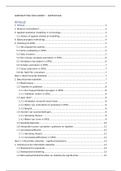Resume
Samenvatting theorie Kwantitatieve data-anlyse SPSS
- Établissement
- Universiteit Gent (UGent)
Deze samenvatting van data-analyse bevat enkel de theorie, als je de samenvatting wilt van de werkcolleges kan je kijken op mijn pagina. Deze samenvatting is op basis van de ppt én het handboek geschreven door Prof. Pauwels
[Montrer plus]



